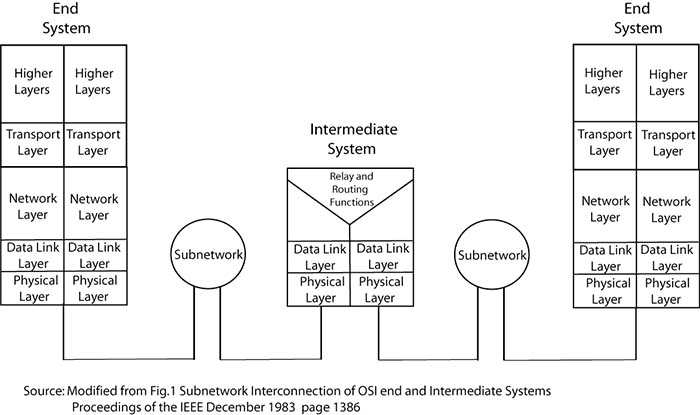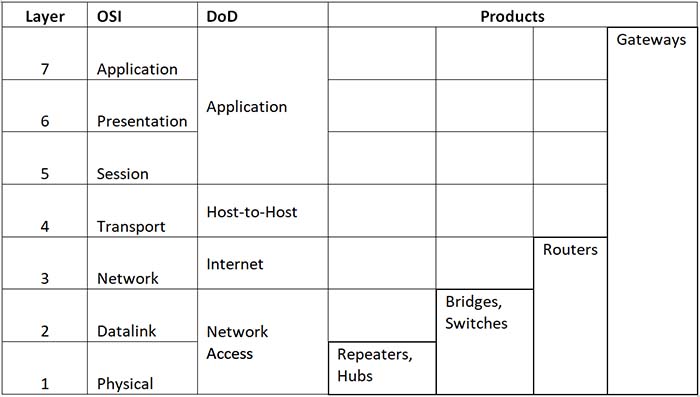Chapter 14 - Internetworking: Emergence 1985-1988
14.4 Gateways/Routers - Network Layer: Integrating Countless Networks
Since the mid-1970s, researchers in the United States (Cerf and Kahn), France (Pouzin), and elsewhere had explored the possibilities of interconnecting different types of packet networks. In 1979, the notion of a network-independent layer had been formalized into the Network Layer in the OSI Reference Model. The architectural challenges of interconnecting multiple networks intensified in the early 1980s with the explosion of different network types such as LANs (Ethernet, token ring, etc.), T-1, X.25, DECnet, for example. Network designers hoped to create Internetworking devices that could support multiple protocols, provide dynamic packet routing around changing line (or link) conditions, and ensure that packets could be routed over links of limited speed. In addition, the addressing had to include the addresses of the source and destination network, as well as devices. This multi-level addressing is similar to postal codes that include the street addresses of senders and recipients as well as the corresponding cities, and even states and countries.
Exhibit 14.4.1 – Network Layer Subnetwork Interconnection

The OSI Reference Model described “Intermediate Systems,” which were Internetworking devices that could implement the Network Layer.6 Intermediate Systems use all the information contained in the headers of packets and can create new protocols between themselves that allow sophisticated forms of control and security beyond the basic relay and routing functions. (See Exhibit 12.4 Network Layer Subnetwork Interconnection)
The subnetworks connecting Intermediate Systems and End Systems can be as many and as diverse as needed to construct a cost effective and reliable enterprise network, a corporate network consisting of many networks. Subnetworks range in complexity from a serial line to unlimited combinations of LANs and WANs. During the mid-1980s, companies brought two new types of Internetworking products to the market: gateways and routers. Products fulfilling the functions that OSI defined for Intermediate Systems. With time, companies realized that building and selling gateways was no simple task. As witnessed, a vast variety of installed LAN and WAN networks existed, and gateway manufacturers struggled to build products that could both interconnect existing networks and anticipate future needs. Yet the continuing demand to communicate packets between networks gave rise to a simpler class of devices, called routers, which were first introduced by Proteon and cisco Systems. Not until 1987 did market research firms begin reporting on this new market sector: Internetworking. (See Exhibit 12.5 Internetworking Revenues 1987 -1988)
Exhibit 14.4.2 – Internetworking Revenues 1987 -1988 ($ Millions)
| Product Category | 1987 | 1988 |
|---|---|---|
| Local Bridges | 24.7 | 47 |
| Remote Bridges | 33.7 | 58 |
| Bridges | 58.4 | 105 |
| Gateways/Routers | 23 | 60 |
| Total Bridges, Gateways and Routers | 81.4 | 165 |
As the Internetworking market grew in 1987 and 1988, the terms “gateway” and “router” gained greater clarity. Routers functioned with protocols at the Network Layer, whereas the more sophisticated gateways integrated the higher-level Layers of once-incompatible computing environments such as DECNET and IBM’s SNA.7 (See Exhibit 12.6, Internetworking Devices in the OSI Model)
In 1988, industry observers brimmed with excitement over the quickening pace of Internetworking evolution and the promising markets for bridges, routers, and gateways. The driving forces were customer demand and global competition, especially among young companies and entrepreneurs who recognized these new opportunities.8 The facilitating framework was ISO’s OSI model and the standards that OSI committees were producing at all levels of the seven-layer OSI Reference Model. As the Internetworking market became reality, only a few questions remained: What companies would capture market leadership? Would IBM commit fully to the momentum of OSI? And, most crucially for customers, how soon would they be able to buy OSI-compliant products?
Exhibit 14.4.3 – Internetworking Devices in the OSI & DoD Models

Two organizations in the U.S. government, ARPA (or DARPA), within the Department of Defense, and the NBS (or as known after August 1988 the NIST), within the Department of Commerce, proved especially influential. (There were, of course, many other government and NGO organizations that contributed, notably the National Science Foundation with its NSFNET that began operations in 1986. The capacities of ARPA and the NBS to buy product, invest in technological innovation, organize workshops and networks, and promote emerging Internetworking technologies were unmatched.9 Despite the prevailing rhetoric of “free markets,” these government agencies took deliberate steps to hasten Internetworking markets towards maturity.
- [6]:
Christine Ware, “The OSI Network Layer: Standards to Cope with the Real World,” Proceedings of the IEEE Volume 71, December 1983, 1384-1387.
- [7]:
Bob Bradley, “Interconnection draws DEC, IBM networks closer,” Data Communications, May 1985, 241-248.
- [8]:
“From Systems to Standards, the Pace Quickens in Networking,” Electronics, April 14 1988.
- [9]:
The NSF was of equal importance.